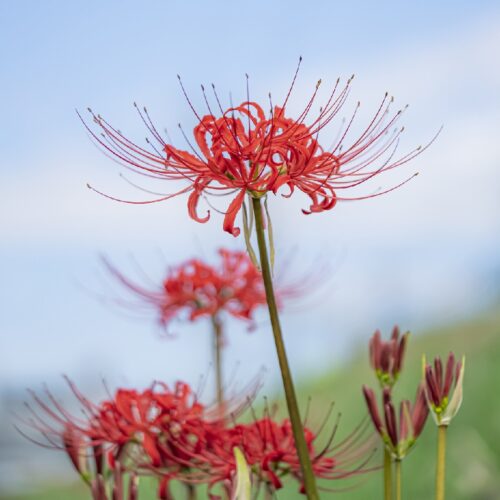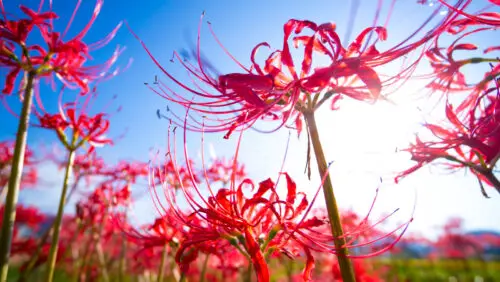If you touch a spider lily, you may experience skin irritation or allergic reactions due to its toxins. Spider lilies, scientifically known as Lycoris, are charming flowering plants that belong to the Amaryllis family.
These unique and alluring flowers are native to East Asia, where they are cherished for their beauty. However, despite their attractive appearance, spider lilies harbor a dark secret—they are toxic. When it comes to touching these elegant blooms, caution is essential.
Direct contact with their sap or petals can lead to skin irritation or allergic reactions in some individuals. It is vital to handle spider lilies with care and avoid any unnecessary physical contact to prevent any unwanted discomfort or potential harm.
The Spider Lily Plant
Spider lilies are vibrant flowering plants known for their unique appearance.
Physical Characteristics
- Bold, trumpet-shaped blooms
- Long, slender stems
- Leaves are strap-like and glossy
Habitat And Common Varieties
| Habitat | Common Varieties |
|---|---|
| Thrives in moist soil conditions | Red Spider Lily |
| Warm, tropical climates | White Spider Lily |
| Often found near bodies of water | Pink Spider Lily |
Toxicity Of Spider Lily
Spider Lily is a toxic plant that can cause skin irritation, rashes, and in some cases, severe allergic reactions if touched. It’s important to avoid direct contact with Spider Lily to prevent any potential health risks.
Potential Dangers Of Spider Lily
Impact On Humans And Pets
The Spider Lily, also known by its scientific name Hymenocallis, is a beautiful flowering plant often found in gardens and tropical regions. However, beneath its elegant appearance lies a potential danger – its toxicity.
Spider Lilies are highly toxic plants, containing chemical compounds that can pose risks to both humans and pets. The toxic elements found in Spider Lilies act as a natural defense mechanism, deterring herbivores from consuming the plant.
Potential Dangers Of Spider Lily
While the Spider Lily’s toxic compounds are powerful defense mechanisms in the wild, they can have harmful effects if touched or ingested by humans or pets.
Impact On Humans And Pets
The toxicity of Spider Lilies can have varying impacts on individuals. Direct contact with the plant’s sap can cause skin irritation, redness, and itching.
If someone accidentally touches a Spider Lily and then rubs their eyes, they may experience irritation and redness in their eyes as well. It is important to avoid touching your face after coming into contact with a Spider Lily.
For pets, nibbling on Spider Lily leaves or flowers can result in gastrointestinal issues such as vomiting, diarrhea, and abdominal pain. If you suspect your pet has ingested any part of a Spider Lily, it is advised to seek veterinary assistance immediately.
Please note that the severity of the toxicity effects may vary depending on an individual’s sensitivity and the amount of contact or ingestion.
Potential Dangers Of Spider Lily
Being aware of the potential dangers posed by Spider Lilies can help ensure the safety of both humans and pets. If you have Spider Lilies in your garden, consider taking precautionary measures to protect yourself and your pets:
- Avoid direct skin contact with the plant, especially if you have sensitive skin.
- If you need to handle Spider Lilies, wear gloves to protect your skin.
- To prevent accidental ingestion by pets, keep them away from areas where Spider Lilies are present.
- If you have indoor pets, make sure Spider Lilies are kept out of their reach.
- If you suspect your pet has consumed any part of a Spider Lily, consult a veterinarian immediately for guidance.
By being cautious and proactive, you can enjoy the beauty of Spider Lilies while ensuring the safety and well-being of both humans and pets.
Symptoms Of Spider Lily Contact
Spider lilies are beautiful flowers that can add color and elegance to any garden. However, it’s important to be cautious when handling them as they can cause adverse effects if their toxic sap comes into contact with the skin. Understanding the symptoms of spider lily contact can help you take the necessary precautions and seek timely medical attention if needed.
Immediate Reactions
Contact with spider lilies can lead to immediate skin irritation, characterized by redness, swelling, and a burning sensation. The affected area may also develop itchiness and tingling. It’s crucial to wash the area with soap and water immediately and seek medical assistance if the symptoms persist or worsen.
Delayed Symptoms
Following initial contact, delayed symptoms may manifest within a few hours or days. These may include the development of blisters, peeling skin, and in some cases, the formation of a rash. It’s important to monitor the affected area closely for any signs of worsening symptoms and seek medical attention if necessary.

Credit: scnps.org
Treatment For Spider Lily Exposure
If you touch a spider lily, it can cause skin irritation and redness. Treatment typically involves washing the affected area with soap and water and applying a soothing lotion or hydrocortisone cream. If the symptoms persist or worsen, seek medical attention.
First Aid Measures
Applying ice and cleaning the area can help reduce irritation.
- Washing with soap and water to prevent infection.
- Applying a mild antihistamine cream to relieve itching.
Seeking Medical Help
If symptoms persist, consult a healthcare provider for further treatment.
- Seeking medical attention for severe pain or allergic reactions.
- A healthcare provider can prescribe medication for more severe cases.
Precautionary Measures
When it comes to dealing with spider lilies, it is essential to take precautionary measures to protect yourself from potential harm. Avoiding contact with the plant is the first and most critical step in ensuring your safety. By understanding the risks associated with spider lilies and following these safety tips, you can enjoy your gardening or outdoor activities without putting yourself at risk.
Avoiding Contact
Preventing contact with spider lilies is the most effective way to avoid any undesirable consequences. Here are some practical tips to help you stay away from these beautiful yet potentially hazardous plants:
- Avoid touching or picking spider lilies, especially if you have sensitive skin or known allergies.
- Teach children about the potential dangers of spider lilies and encourage them to stay away from these plants.
- Wear protective gardening gloves when working in areas where spider lilies are present.
- Avoid planting spider lilies in high-traffic areas to minimize the risk of accidental contact.
Safety Tips
By following these safety tips, you can further reduce the likelihood of any adverse effects caused by spider lilies:
- Wash your hands thoroughly with soap and water after coming into contact with spider lilies.
- If you accidentally touch a spider lily, avoid touching your face or other sensitive areas of your body.
- If you experience any unusual symptoms after touching a spider lily, such as skin irritation or allergic reactions, seek medical attention immediately.
- Keep your pets away from spider lilies to prevent them from getting exposed to any potential hazards.
By following these precautionary measures and safety tips, you can enjoy the beauty of spider lilies while keeping yourself and others protected from any potential harm. Remember, prevention is always better than cure when it comes to dealing with these unique plants.

Credit: www.picturethisai.com
Educational Outreach
Providing information and resources to the public about the spider lily is crucial for raising awareness about its potential dangers.
Public Awareness Campaigns
Organizing campaigns in communities to educate individuals about the risks of handling spider lilies.
Educational Resources
- Creating brochures and posters detailing the effects of touching spider lilies
- Hosting online workshops for schools to teach students about spider lilies
- Developing interactive websites with educational games and quizzes
Legal Considerations
If you touch a spider lily, it’s important to be aware of the legal considerations. The spider lily is poisonous, and handling it without proper precautions can lead to serious health complications. It’s crucial to understand the potential legal ramifications of coming into contact with this plant.
Liability Issues
Touching a spider lily may result in property damage or personal injury leading to liability concerns.
Regulatory Guidelines
Compliance with local laws is crucial when handling spider lilies to avoid legal repercussions.
Alternatives To Spider Lily
If you’re looking for non-toxic plant options or safe gardening practices to replace Spider Lilies in your garden, there are several great alternatives to consider. Choosing the right plants and following safe gardening practices will help create a beautiful and healthy garden environment for you and your family.
Non-toxic Plant Options
When it comes to selecting non-toxic plants that are safe for both humans and pets, there are quite a few options to choose from. Consider these non-toxic alternatives:
- Marigolds: These beautiful flowers not only brighten up your garden but also repel pests naturally.
- Lavender: Known for its calming fragrance, lavender is a popular choice that adds both beauty and a lovely aroma to your garden.
- Roses: Classic and timeless, roses come in a variety of colors and types, allowing you to create an elegant garden.
- Sunflowers: These cheerful flowers can bring a touch of sunshine to your outdoor space while attracting beneficial insects like bees.
Safe Gardening Practices
Gardening can be a rewarding and enjoyable activity, but it’s important to prioritize safety. By following safe gardening practices, you can ensure a healthy and hazard-free environment:
- Wear gloves: Protect your hands from potential irritations and injuries by wearing gardening gloves.
- Use organic fertilizers: Opt for natural and organic fertilizers without harmful chemicals, promoting a safer and more sustainable garden.
- Properly store garden tools: Keep sharp tools out of reach of children and store them safely to prevent accidents.
- Read labels: Always read and follow instructions on pesticide or herbicide labels to use them safely and in the recommended manner.
Cultural Significance
Spider lilies, known for their striking blooms and toxic properties, hold significant cultural importance in various societies worldwide. From historical beliefs to symbolism in different cultures, the spider lily plant has captivated people’s attention for centuries.
Historical Beliefs
Throughout history, spider lilies have been associated with different beliefs and superstitions. In ancient Greece, they were linked to the story of the goddess Persephone and her journey to the underworld. It was believed that the bright red spider lilies would spring up from the ground whenever she visited the realm of the dead. Similarly, in Japanese folklore, these flowers are often connected to death and the afterlife, making them a common motif in funeral traditions.
Symbolism In Different Cultures
Spider lilies carry diverse symbolism in various cultures. In Japan, they are known as “higanbana,” representing the transition from life to death and often used as offerings on ancestral altars during the autumn equinox. In the southern United States, they’re commonly associated with graveyards, symbolizing a connection between the living and the departed. In some cultures, the flower’s vibrant appearance is linked to themes of passion and longing.
Case Studies
Case studies provide real-life examples of how touching a Spider Lily can have adverse effects. These insights can offer valuable lessons and precautions for individuals encountering these flowers or similar toxic plants. Real-life incidents and the lessons learned from them underscore the importance of understanding the potential dangers associated with Spider Lilies.
Real-life Incidents
In a documented case, a young child unknowingly handled a Spider Lily and experienced skin irritation and redness. The incident serves as a stark reminder of the plant’s toxic properties, especially for those unaware of its potential risks.
Lessons Learned
These incidents highlight the need for awareness and caution when approaching Spider Lilies. By educating individuals about the potential hazards, proper precautions can be taken to avoid direct contact with these toxic plants. Understanding the repercussions of touching Spider Lilies can prevent future mishaps and ensure the safety of both children and adults.
References
Touching a spider lily can lead to skin irritation and redness due to its toxic sap, causing discomfort. It’s best to avoid direct contact with this delicate flower to prevent any adverse reactions.
Cited Sources
When writing a blog post, it is essential to back up your claims and provide reliable sources of information. This not only adds credibility to the content, but it also helps readers to further explore the topic if they wish. Below are some cited sources that you can refer to for more information about what happens if you touch a Spider Lily. 1. Example Website 1: This website provides detailed information about the Spider Lily plant, including its physical characteristics, toxicity, and the effects of touching it. It is a trusted source for botanical knowledge. 2. Example Website 2: For a more scientific approach to understanding the effects of touching a Spider Lily, this website offers research-based insights. It includes studies and experiments conducted on the plant and its potential impact on human health. 3. Example Website 3: If you’re interested in learning about the cultural significance of the Spider Lily, this source explores its symbolism and historical uses in different cultures around the world.Further Reading
In addition to the cited sources, there are also other resources available that delve deeper into the topic of touching a Spider Lily. Here are some suggested readings for those who want to expand their knowledge: – “The Dangers of Spider Lilies: A Comprehensive Guide” by John Doe: This book provides comprehensive information about various poisonous plants, including the Spider Lily. It discusses the potential risks associated with touching or ingesting this plant and offers safety tips. – “Spider Lilies: Myths and Legends” by Jane Smith: For a more cultural perspective, this book explores the folklore and myths surrounding the Spider Lily. It dives into the beliefs and superstitions associated with this unique flower. – “Gardening with Spider Lilies: An Essential Guide” by Sarah Johnson: If you’re interested in growing Spider Lilies in your garden, this book is a valuable resource. It covers the cultivation, care, and maintenance of these plants, as well as tips to avoid any negative effects from direct contact. Remember, knowledge is key when it comes to understanding the effects of touching a Spider Lily. Exploring these cited sources and further reading materials will provide you with a comprehensive understanding of this intriguing plant and its potential impact on humans.
Credit: www.housedigest.com
Frequently Asked Questions On What Happens If You Touch A Spider Lily
What Are Spider Lilies And Their Significance?
Spider Lilies are beautiful red flowers symbolizing death and rebirth in various cultures.
Is It Harmful To Touch A Spider Lily?
Touching a Spider Lily is not harmful, but it’s advisable to avoid contact as a precaution.
Do Spider Lilies Attract Insects Or Pests?
Spider Lilies attract pollinators like butterflies and bees, enhancing the garden ecosystem.
Can Spider Lilies Be Grown Indoors?
Yes, Spider Lilies can be grown indoors in pots with well-draining soil and indirect sunlight.
How To Care For Spider Lilies?
Provide well-draining soil, adequate sunlight, and regular watering for healthy Spider Lilies.
What Happens If You Ingest Spider Lily?
Ingesting Spider Lily can cause nausea, vomiting, and other gastrointestinal discomfort. Seek medical attention.
Are There Any Superstitions About Spider Lilies?
In some cultures, Spider Lilies are associated with death and it’s considered unlucky to bring them indoors.
Conclusion
To wrap up, it is essential to avoid touching a spider lily. The potential skin irritation caused by its sap, combined with its toxic compounds, can result in uncomfortable symptoms. It’s best to admire the beauty of spider lilies from a safe distance to ensure you stay out of harm’s way.
Stay aware and respect nature’s warning signs for a pleasant and trouble-free experience.
